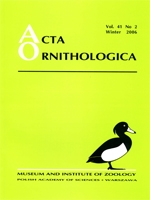Phasianid galliform birds do not occur in Europe before the end of the early Oligocene, and their Paleogene fossil record mainly comprises isolated bones. Here we describe a nearly complete and articulated skeleton of a phasianid galliform bird from the late Oligocene of Enspel in Germany. The specimen is assigned to Palaeortyx cf. gallica Milne-Edwards, 1869 and for the first time allows the recognition of cranial and pelvic details in a late Oligocene phasianid. Many gizzard stones are preserved in both the gizzard and the crop, and constitute the earliest fossil evidence for grit use in a phasianid galliform.
How to translate text using browser tools
21 January 2022
A Nearly Complete Skeleton of the Fossil Galliform Bird Palaeortyx from the Late Oligocene of Germany
Gerald Mayr,
Markus Poschmann,
Michael Wuttke
ACCESS THE FULL ARTICLE

Acta Ornithologica
Vol. 41 • No. 2
December 2006
Vol. 41 • No. 2
December 2006
fossil birds
Galliformes
gizzard stones
Oligocene
Palaeortyx




